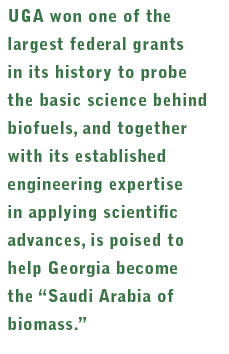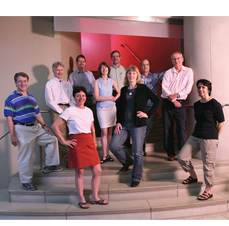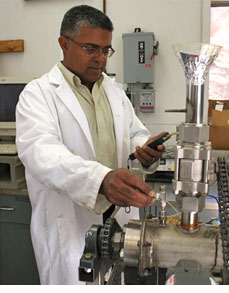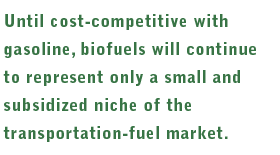





The “micro” scientists—biochemists, geneticists and molecular biologists are working at the cellular level to break down plants more easily for refining.
UGA researchers in the new Bioenergy Science Center include (left to right): Wayne Parrott, Alan Darvill, Janet Westpheling, Mike Adams, Katrien Devos, Michael Hahn, Deb Mohnen, Jeffrey Bennetzen, Will York and Sue Wessler. Not pictured: Ying Xu, Malcolm O’Neill, Charles Brummer, Maor Bar-Peled and Shavannor Smith.
![]()

K.C. Das, director of UGA’s biorefining and carbon recycling program, works on ways to turn wastes such as poultry litter, into biofuels.
![]()
You won’t find any derricks or oil-well pumps in Georgia like those that dot the landscapes of Texas and Oklahoma. Georgia has no known commercially viable deposits of bubbling crude.
What Georgia does have is abundant farmland and forestland teeming with huge amounts of biomass—raw material for making ethanol and biodiesel, the so-called biofuels. The state has 24 million acres of commercial forests, an expanse second only to Oregon’s. Georgia’s farms are capable of producing millions of tons of other biomass—including switchgrass, peanuts, sweet sorghum, soybeans, corn, wheat, and canola. And the potential doesn’t end there. Grasses, cornstalks, sawdust, hog manure, paper pulp, and logging debris are all possible raw materials, or feedstocks, for biofuels. Georgia’s poultry-processing plants alone annually produce millions of gallons of chicken fat that could be rendered into biodiesel.
Given these vast “reserves,” the University of Georgia’s Ryan Adolphson and other bioenergy experts envision the state as a leading biofuels producer—in effect, “the Saudi Arabia of biomass.” But until biofuels become cost-competitive with gasoline, UGA researchers say, they will continue to represent only a small and subsidized niche of the transportation-fuel market.
To fully tap biomass as a major fuel source will require a slew of scientific and technological advances that range from a basic understanding of plant growth, to the genetic engineering of biomass that will make it more amenable to efficient refining methods. The DOE is pushing hard to speed up such research—a mission, some say, that may ultimately rival the manned moon-landing program of the 1960s both in scale and ambition.
From Basic Science to Useful Products
Poised to play a pivotal role in this new “moonshot” is the University of Georgia, which will be a lead player in one of the nation’s most extensive bioenergy-research projects to date—an endeavor to unravel the tightly held secrets of cellulosic biomass, a basic component of green plants and a key factor in the mass production of biofuels. A primary goal is to make so-called cellulosic ethanol cost-competitive with gasoline by 2012, which should help reduce America’s gasoline consumption by 20 percent in the 10 years thereafter.
 Alan Darvill, cofounder and director of the Complex Carbohydrate Research Center (CCRC), is heading the grant team, which will work in collaboration with researchers at several other select institutions. Together, they will comprise a new research center—the Bioenergy Science Center (BESC)—headquartered at Oak Ridge National Laboratory in Tennessee. Other members include Georgia Tech, the University of Tennessee, Dartmouth College, the Samuel Roberts Noble Foundation, and the National Renewable Energy Laboratory. The center also includes companies—ArborGen in Summerville, S.C.; Diversa in San Diego, Calif.; and Mascoma in Cambridge, Mass.—as well as several independent researchers from around the country.
Alan Darvill, cofounder and director of the Complex Carbohydrate Research Center (CCRC), is heading the grant team, which will work in collaboration with researchers at several other select institutions. Together, they will comprise a new research center—the Bioenergy Science Center (BESC)—headquartered at Oak Ridge National Laboratory in Tennessee. Other members include Georgia Tech, the University of Tennessee, Dartmouth College, the Samuel Roberts Noble Foundation, and the National Renewable Energy Laboratory. The center also includes companies—ArborGen in Summerville, S.C.; Diversa in San Diego, Calif.; and Mascoma in Cambridge, Mass.—as well as several independent researchers from around the country.
“This research uses biotechnology to reduce the high cost of processing trees and other plants into biofuels,” says Darvill, “and has the potential to make ethanol a significant replacement for fossil fuels for this country’s future energy needs.”
The DOE announced in June that it would invest up to $375 million over the next five years in BESC and two similar research consortiums—one based in Madison, Wis., and the other near Berkeley, Calif.—on basic science that may aid the development of cellulosic ethanol and other biofuels. Worth noting is that these three consortia were the survivors of an intense competition—and that CCRC’s strengths in plant cell-wall structure analysis, plant genetics, and microbial biochemistry were major factors in BESC’s win. The center is slated to receive $125 million, of which UGA’s portion will be about $20 million.
Advances in such fundamental science are critical to the applications—biofuels as a major energy resource—down the road. UGA can thus be a major player on both counts: its strength in basic research and its engineering expertise in applying the science to derive useful products.
Much of UGA’s past applied work has centered on its “integrated biorefinery,” built on campus in 2004. This facility “is unique,” says E. Dale Threadgill, head of UGA’s faculty of engineering, because it can process a variety of biomass types—from wood chips to chicken manure—to generate both liquid fuels and bioproducts. Moreover, says Adolphson, who directs UGA’s biomass-processing facilities, “We’re looking at the broad spectrum of biomass-to-energy—similar to how a petroleum refinery takes a barrel of crude and makes not just gasoline and diesel but also many other useful products.”
Toward Easing the Pain
Biofuels themselves are nothing new. Henry Ford initially planned to use ethanol (the alcohol in alcoholic beverages) as the primary fuel for his Model T. German engineer Rudolf Diesel designed the first engine bearing his name to run on peanut oil or vegetable oil, as he demonstrated at the World Exhibition in Paris in 1900.
But even in the early going, biofuels took a back seat to oil. Ford opted for gasoline as the dominant fuel for his cars because it was cheaper, and in the ensuing decades biofuels stayed in the backseat. Then came the Arab oil embargoes of 1973 and 1979, when gasoline prices in the United States shot up and long lines appeared at gas stations because of shortages. These “crises,” as they came to be known, made the nation realize how vulnerable it was to the whims of foreign oil producers.
As a result, biofuels gained renewed interest among researchers, including an enthusiastic group at UGA. In a pilot project, several campus buses were modified to run on diesel blended with up to 80 percent peanut oil. During February 2002, the university heated the entire campus for six weeks using animal fats, oil, and grease—substitutes for No. 2 fuel oil. Based on UGA research, electricity was generated in north Georgia in 2004 by burning chicken litter.
Most of these biofuels demonstrations received only nominal public attention, however, as petroleum fuels were again plentiful.
But now, several phenomena have converged to push biofuels to center stage—and probably keep them there. Global oil demand is growing fast, while supplies are tightening. Tension is brewing in several oil-rich regions, jeopardizing their reliability as future oil sources for the United States. The worldwide price of oil has soared to as much as $77 a barrel.
Consumers are feeling the pinch at the pump, where gasoline prices have hovered around $3 per gallon, and predictions are that the situation will worsen instead of improve.
In addition, global warming, which a majority of scientists say is caused mostly by fossil-fuel burning, has become a major threat around the world.
Biofuels can help ease much of this pain, scientists say. For one thing, burning biofuels instead of petroleum can produce fewer emissions of carbon monoxide, particulates, and other contaminants, thereby relieving areas plagued with air pollution. And biofuels could also slash emissions of carbon dioxide—the main gas behind global warming. K.C. Das, director of UGA’s biorefining and carbon cycling program and his colleagues are working on methods that would allow the widespread use and production of biofuels while “sequestering carbon” in the soil to keep excess amounts of it out of the air.
For comments or for information please e-mail: rcomm@uga.edu
To contact the webmaster please email: ovprweb@uga.edu
![]()